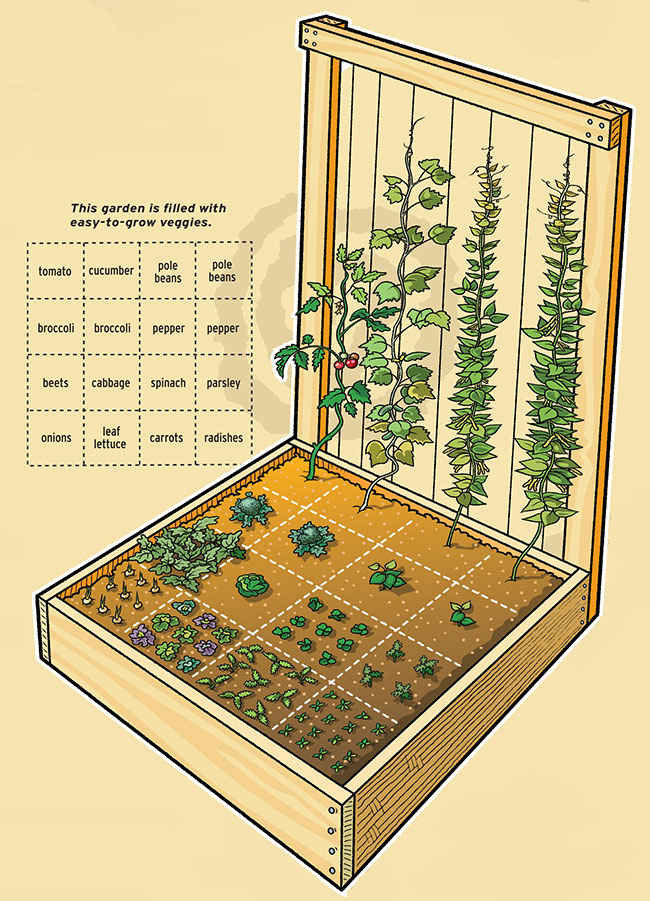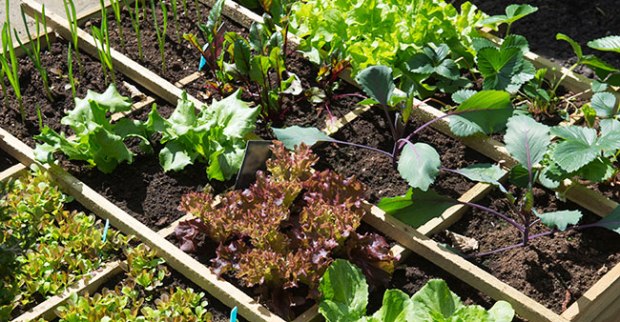How to Plant a Compact Vegetable Garden
What makes this compact garden so productive is that you will be placing plants close together in squares instead of traditional rows. You can continue to plant as you harvest.

What You’ll Need
- Hammer
- Saw
- Shovel
- Wire cutters
- Tape measure
- 4 4-foot 2-by-10’s
- 16d galvanized nails
- 2 6-foot 2-by-4’s
- 4-foot 2-by-4
- 49 feet of 12-gauge galvanized wire, cut into 7 7-foot lengths
- 8d galvanized nails
- About 1/2 cubic yard or 14 cubic feet of good garden soil
- A sunny spot for your garden
What You’ll Do
Frame
1. Using the 2-by-10’s and 16d nails, hammer together a 4-foot square.
Trellis
2. Nail the 6-foot 2-by-4’s to the back of the frame.
3. Nail the 4-foot 2-by-4 across the back of the uprights.
4. Attach the 7 wires on the back of the trellis by wrapping wires around nails.

Planting
Fill the frame with good garden soil. Divide it into 16 squares. The smaller the mature plant, the more you can plant in each square.
A Helpful Garden
Nail 5/8-inch or heavier exterior plywood to the bottom of the frame and lift the frame to table height by placing it on sturdy saw horses or legs. Once filled with soil, it will be easily accessible to a person in a wheelchair or someone who is more comfortable sitting than kneeling.
while this method is great for starting out most plants that grow in areas that small tend to be undersized need more fertilizer and mildew more easily which is why professional gardeners plant vegetables in rows instead of raised beds or in close proximity to other plants
How many people can this feed?
If you put plywood on bottom..wouldn’t that cause mold and mildew ?
how do you protect your plantings from rabbits/birds etc?
What kept the squirrels and rabbits at bay around my house was a solution with cayenne pepper. It seemed to work quite well. I didn’t have trouble with birds as they ate any slugs or other insects that would have damaged my plants.
Look up companion planting and natural pest deterrents. By planting certain herbs, flowers or other veggie plants next to each other it wards off pests and critters by either rappelling them or attracting beneficial insects that will eat the bad ones. Most critters do not like marigolds, mint, oregano, lavender etc…
A better solution would be to use thick cardboard – not plywood. It will protect from weeds, kill grass underneath, attract earth worms (good for soil) and provide nutrients as it decays.
This is a great garden! I wish I could duplicate it somehow!
If you’re leaving it on the ground that would work, but the point in making a bottom in the first place is to be able to raise it, and cardboard wouldn’t be sturdy enough.
Beautiful idea!
Read the book Square foot gardening by Mel Bartholomew. He has a similar method. It is easy and fabulous. I have five boxes that feed our family of four very we’ll.
Looks like a nice garden ! Just big enough for my husband and I.
Marine grade ply will last
We built a raised bed similar to this but much bigger. We used cedar 6 x 6 removed the grass so no bottom was required on the structure. One side has asparagus that provides a great supply in early spring. The other is mostly herbs and tomatoes and rhubarb. I will try to add a trellis in the middle and try growing some runner beans along side the tomatoes.
We also plant tomatoes against our board fence and we get 8 foot plants that really produce. You just have to tie them to the fence in spots to help hold the weight.
All the plants in the diagram should not be planted at the same time. Most of them are to be planted in the Fall.
real method of growing our own veggies